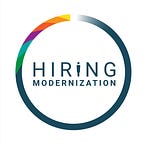The hiring process broken down into service modules
At this point in the process, we wanted to introduce the concept of service modules. We have always defined hiring as being a service. It is in many ways a service that you are offering to hiring managers and candidates, and at every moment in the process you want to ensure you are offering the best user experience possible.
- For hiring managers that means ensuring they understand the hiring process, are supported along the way, and hire the right people at the right time
- For candidates that means ensuring they have the best hiring experience so they can get a taste of what it might be like to work for that organization, spread the excitement with their friends/colleagues/families, and — even if they don’t get hired — be reminded of this organization again a few years later when they are looking for their next opportunity.
This is not a change that will happen overnight, but this is always in the back of our minds as we continue to improve and make sense of this complex process.
Redesigning the government hiring process requires us to think in service modules
We’ve synthesized our journey maps again and introduced a new framework. This framing will serve as the foundation for organizing our prototypes/tests/recommendations and provide a common (accessible!) language for understanding the objectives of each part of the hiring process.
With this, we’ve now been able to associate pain points (from all 3 users: HR, hiring managers and candidates) to each one of these modules:
How all of this comes together
These service modules now offer us a platform to organize valuable information in a way that pushes us to suggest a modular procurement approach. This is incredibly valuable, as we start thinking about what might be best.
We don’t want: to procure 1 monolithic system that only sort-of meets the needs of users and objectives of each module.
We want: to procure 2, 3, 7, or more different systems that meet the needs of users throughout this entire service and meet the objectives of each module. Breaking the process up into smaller chunks allows us to implement in a structured manner, gather feedback and adapt where we need to.
Let’s take the example of “Getting the word out”:
What we can start to bucket here is:
- Pain points that keep this module grounded in the needs of the users
- Larger visions/goals for what resources, policies and operations we need in place for this to work really well. The idea that came out of one of our ideation sessions was creating a department of marketing to focus on employment brand, content and social media. This idea would obviously not be implemented overnight. Instead we’d have a roadmap indicating key activities that would need to be completed 3, 6, 9 months out to slowly build this out and test whether or not this actually makes sense and yields the objectives we want to see.
- Lessons learned from current projects or prototypes that dictate what the software needs to do and accompanying metrics to monitor progress and success. For example: what would it look like to have a feature in the new Applicant Tracking System that automatically posted opportunities to job boards and social media outlets with a single click.
What’s next:
We’re continuing to host ideation sessions and conduct research to build out each one of these modules. We’ll also be testing some prototypes and are excited to report on those in the next post! As always, feel free to reach out at any time: monique.baena-tan@sfgov.org
-David and Monique
Incase you’re interested, here are some readings on modular RFPs:
- 18F’s article on modular procurement
- Jen Pahlka’s article on government vendors
- The first modular procurement for modernizing Alaska’s Medicaid Eligibility System on GitHub
Monique Baena-Tan is Researcher and Service Designer for the Hiring Modernization Project. Most recently Monique led design research on Code for America’s talent initiative which included a job board to help technologists find opportunities in public interest tech, and documented best practices across the country in government hiring.
David Huebner is Project Manager and Strategy Advisor for the Hiring Modernization Project. He most recently worked at Code for America where he led a talent initiative focused on helping governments improve their people practices to ensure they can hire and retain technologists to deliver services most effectively. Previously, David worked at Google as a Manager on a strategy, analytics and effectiveness team focusing on hiring and people services.
